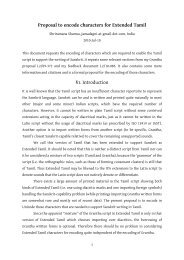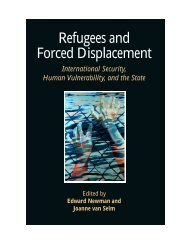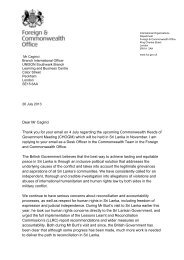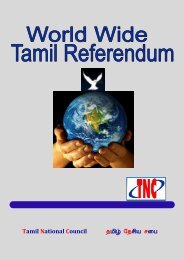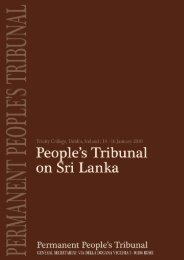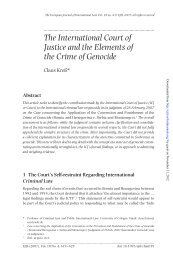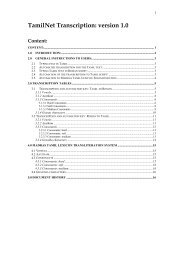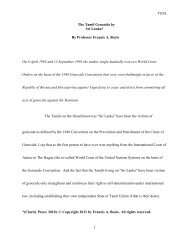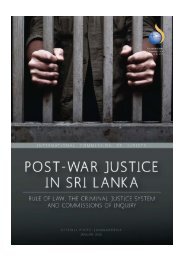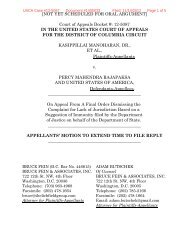Census in Colonial India and the Birth of Caste - TamilNet
Census in Colonial India and the Birth of Caste - TamilNet
Census in Colonial India and the Birth of Caste - TamilNet
You also want an ePaper? Increase the reach of your titles
YUMPU automatically turns print PDFs into web optimized ePapers that Google loves.
SPECIAL ARTICLE<br />
<strong>Census</strong> <strong>in</strong> <strong>Colonial</strong> <strong>India</strong> <strong>and</strong> <strong>the</strong> <strong>Birth</strong> <strong>of</strong> <strong>Caste</strong><br />
Padmanabh Samarendra<br />
<strong>Caste</strong>, as conceived <strong>in</strong> contemporary academic writ<strong>in</strong>gs<br />
or with<strong>in</strong> <strong>the</strong> policies <strong>of</strong> <strong>the</strong> State, is a new idea produced<br />
dur<strong>in</strong>g <strong>the</strong> second half <strong>of</strong> <strong>the</strong> 19th century <strong>in</strong> <strong>the</strong> course<br />
<strong>of</strong> <strong>and</strong> because <strong>of</strong> <strong>the</strong> census operations. <strong>Colonial</strong> census<br />
<strong>of</strong>ficials, work<strong>in</strong>g with concepts <strong>of</strong> varna <strong>and</strong> jati,<br />
struggled unsuccessfully to def<strong>in</strong>e <strong>and</strong> classify <strong>the</strong>se <strong>in</strong>to<br />
castes on a s<strong>in</strong>gle pan-<strong>India</strong> list, where each caste had to<br />
be discreet, homogeneous <strong>and</strong> enumerable. The history<br />
<strong>of</strong> caste enumeration <strong>in</strong> <strong>the</strong> <strong>India</strong>n census illustrates how<br />
difficult it is to capture <strong>in</strong>digenous social hierarchies <strong>and</strong><br />
identities under <strong>the</strong> term “caste”. We embark on a new<br />
caste census without hav<strong>in</strong>g addressed many <strong>of</strong><br />
<strong>the</strong>se challenges.<br />
The proposal <strong>of</strong> <strong>the</strong> Government <strong>of</strong> <strong>India</strong> to conduct a caste<br />
– census has generated <strong>in</strong>tensely conflict<strong>in</strong>g responses<br />
with<strong>in</strong> <strong>and</strong> outside <strong>the</strong> <strong>India</strong>n Parliament. Those <strong>in</strong> favour<br />
<strong>of</strong> <strong>the</strong> proposal argue that <strong>the</strong> survey would reveal <strong>the</strong> identity<br />
<strong>and</strong> numerical strength <strong>of</strong> <strong>the</strong> castes which suffer from deprivation;<br />
this <strong>in</strong> turn would help <strong>the</strong> state <strong>in</strong> reformulat<strong>in</strong>g <strong>and</strong> extend<strong>in</strong>g<br />
policies, such as that <strong>of</strong> reservation, which would <strong>the</strong>n<br />
ensure <strong>the</strong> upliftment <strong>of</strong> <strong>the</strong> deprived sections. Those argu<strong>in</strong>g<br />
aga<strong>in</strong>st <strong>the</strong> enumeration <strong>of</strong> caste believe that <strong>the</strong> measure contravenes<br />
<strong>the</strong> ideals <strong>of</strong> citizenship <strong>and</strong> would foster divisive tendencies<br />
with<strong>in</strong> society <strong>and</strong> <strong>the</strong> polity <strong>of</strong> <strong>the</strong> nation.<br />
Notwithst<strong>and</strong><strong>in</strong>g <strong>the</strong> o<strong>the</strong>r differences, both <strong>the</strong> protagonists<br />
<strong>and</strong> antagonists <strong>in</strong> this debate st<strong>and</strong> toge<strong>the</strong>r when shar<strong>in</strong>g <strong>the</strong><br />
follow<strong>in</strong>g premises: <strong>the</strong>y believe that caste is an <strong>in</strong>dubitable reality<br />
<strong>of</strong> <strong>India</strong>n social life; that it has been so s<strong>in</strong>ce <strong>the</strong> earliest times;<br />
<strong>and</strong> that <strong>the</strong> census could map this reality <strong>and</strong> produce castedata.<br />
In <strong>the</strong> present paper I adopt a contrast<strong>in</strong>g stance. I argue<br />
that caste, as conceived <strong>in</strong> contemporary academic writ<strong>in</strong>gs or<br />
with<strong>in</strong> <strong>the</strong> policies <strong>of</strong> <strong>the</strong> state, is a new idea <strong>and</strong> that <strong>the</strong> social<br />
form imag<strong>in</strong>ed through this term never characterised <strong>the</strong> <strong>India</strong>n<br />
society. Fur<strong>the</strong>r, I suggest that this idea <strong>of</strong> caste was produced<br />
towards <strong>the</strong> end <strong>of</strong> <strong>the</strong> 19th century <strong>in</strong> <strong>the</strong> course <strong>of</strong> <strong>and</strong> because<br />
<strong>of</strong> <strong>the</strong> census operations.<br />
The paper has benefited from <strong>the</strong> comments made by Gautam Bhadra,<br />
Neeladri Bhattacharya, Rohan D’Souza, <strong>and</strong> scholars from <strong>the</strong><br />
Department <strong>of</strong> History <strong>and</strong> Culture, Jamia Millia Islamia <strong>and</strong> Centre for<br />
Historical Studies, Jawaharlal Nehru University. Sangeeta DasGupta has<br />
read <strong>the</strong> manuscript <strong>and</strong> suggested extensive changes. I am thankful to<br />
all <strong>of</strong> <strong>the</strong>m. The usual disclaimers apply.<br />
Padmanabh Samarendra (psamarendra@hotmail.com) is at <strong>the</strong><br />
Dr K R Narayanan Centre for Dalit <strong>and</strong> M<strong>in</strong>orities Studies, Jamia Millia<br />
Islamia, New Delhi.<br />
<strong>Caste</strong> <strong>of</strong> <strong>the</strong> Jati<br />
I beg<strong>in</strong> by submitt<strong>in</strong>g that caste is a foreign word. Derived perhaps<br />
from <strong>the</strong> Portuguese “casta”, this word could not have been<br />
<strong>in</strong> circulation for more than past three to four centuries. The<br />
would-be critics <strong>of</strong> this paper might respond by stat<strong>in</strong>g that even<br />
if <strong>the</strong> word is new, its connotation is not so. What does caste connote?<br />
The scholars, <strong>in</strong> general, have <strong>in</strong>terpreted caste as an<br />
equivalent <strong>of</strong> varna or/<strong>and</strong> jati, entities that have been parts <strong>of</strong><br />
<strong>the</strong> <strong>in</strong>digenous traditions.<br />
If it can be demonstrated that <strong>the</strong> attributes <strong>of</strong> caste match with<br />
that <strong>of</strong> ei<strong>the</strong>r varna or jati <strong>the</strong>n <strong>the</strong> hypo<strong>the</strong>sis that I propose<br />
would certa<strong>in</strong>ly st<strong>and</strong> rejected. Yet even a cursory look at <strong>the</strong><br />
scholarly writ<strong>in</strong>gs reveals widespread confusion <strong>and</strong> uncerta<strong>in</strong>ty<br />
on <strong>the</strong> issue. For example, M N Sr<strong>in</strong>ivas equates caste with jati <strong>and</strong><br />
not varna. In an article entitled “Varna <strong>and</strong> <strong>Caste</strong>” (evidently caste<br />
here means jati), he writes: “The varna-model has produced a<br />
wrong <strong>and</strong> distorted image <strong>of</strong> caste. It is necessary for <strong>the</strong> sociologist<br />
to free himself from <strong>the</strong> hold <strong>of</strong> <strong>the</strong> varna-model if he wishes<br />
to underst<strong>and</strong> <strong>the</strong> caste system” (Sr<strong>in</strong>ivas 1962: 66). McKim Marriott<br />
<strong>and</strong> Ronald Inden differ with Sr<strong>in</strong>ivas. They do not reject <strong>the</strong><br />
relevance <strong>of</strong> <strong>the</strong> varna model; fur<strong>the</strong>r <strong>the</strong>y argue that jati does not<br />
exclusively refer to caste. “The South Asian word jati”, <strong>the</strong>y write,<br />
“refers to a great many k<strong>in</strong>ds <strong>of</strong> th<strong>in</strong>gs o<strong>the</strong>r than those we mean<br />
Economic & Political Weekly EPW August 13, 2011 vol xlvI no 33 51
SPECIAL ARTICLE<br />
by <strong>the</strong> word ‘caste’. It refers to all sorts <strong>of</strong> categories <strong>of</strong> th<strong>in</strong>gs”<br />
(Marriott <strong>and</strong> Inden 1977: 230). Some scholars have tried to sidestep<br />
<strong>the</strong> whole problem by comb<strong>in</strong><strong>in</strong>g <strong>the</strong> two terms: Susan Bayly<br />
writes about <strong>the</strong> “varna jati norms” (Bayly 2002: 25, see also, 12),<br />
while Suvira Jaiswal <strong>in</strong> her book traces “<strong>the</strong> orig<strong>in</strong>s <strong>of</strong> <strong>the</strong> varna<br />
caste [jati] structure” (Jaiswal 2000: ix).<br />
Such formulations, I should po<strong>in</strong>t out, disregard <strong>the</strong> widely<br />
shared consensus that varna <strong>and</strong> jati are two dissimilar concepts<br />
which implies that toge<strong>the</strong>r <strong>the</strong>se cannot constitute a s<strong>in</strong>gular set<br />
<strong>of</strong> norms or a s<strong>in</strong>gle structure. So what is caste – varna or jati?<br />
Fur<strong>the</strong>r, when <strong>the</strong> scholars write about <strong>the</strong> pan-<strong>India</strong>n caste system<br />
what are <strong>the</strong>y referr<strong>in</strong>g to – a system <strong>of</strong> varna or that <strong>of</strong> <strong>the</strong><br />
jatis? Contrary to <strong>the</strong> broadly shared belief, <strong>the</strong> problems faced<br />
by <strong>the</strong> scholars <strong>in</strong> equat<strong>in</strong>g caste with ei<strong>the</strong>r varna or jati, I<br />
believe, allude to <strong>the</strong> non-equivalence <strong>of</strong> <strong>the</strong>se terms.<br />
In order to illustrate <strong>the</strong> dist<strong>in</strong>ction between caste vis-à-vis<br />
varna <strong>and</strong> jati, I briefly look <strong>in</strong>to <strong>the</strong>ir mean<strong>in</strong>gs. <strong>Caste</strong> has been<br />
variously def<strong>in</strong>ed as an endogamous, ethnic, occupational, ritualistic<br />
or racial division. Underly<strong>in</strong>g all <strong>the</strong>se def<strong>in</strong>itions are<br />
present <strong>the</strong> follow<strong>in</strong>g two assumptions: that caste actually exists<br />
<strong>and</strong> can be observed <strong>in</strong> society, <strong>and</strong> that it has a fixed <strong>and</strong> uniform<br />
boundary imply<strong>in</strong>g that communities called caste across<br />
<strong>India</strong> have someth<strong>in</strong>g <strong>in</strong> common.<br />
The varna order, when compared, seems to share <strong>the</strong> def<strong>in</strong>itiveness<br />
<strong>of</strong> caste: as mentioned <strong>in</strong> <strong>the</strong> Sanskrit texts <strong>the</strong>re are four<br />
groups with<strong>in</strong> this order <strong>the</strong> attributes <strong>of</strong> which are more or less<br />
consistent. Yet, unlike caste, <strong>the</strong> scholars po<strong>in</strong>t out, <strong>the</strong> varna system<br />
is text-based <strong>and</strong> does not exist on <strong>the</strong> social pla<strong>in</strong> <strong>in</strong> <strong>the</strong> same<br />
form. No society across <strong>the</strong> <strong>India</strong>n subcont<strong>in</strong>ent is actually divided<br />
<strong>in</strong>to merely four groups <strong>of</strong> brahm<strong>in</strong>, kshatriya, vaishya <strong>and</strong> shudra.<br />
The presence <strong>of</strong> <strong>the</strong> jatis, on <strong>the</strong> o<strong>the</strong>r h<strong>and</strong>, can be observed <strong>in</strong><br />
society. The similarity with caste however ends <strong>the</strong>re. The connotation<br />
<strong>of</strong> jati, <strong>in</strong> contrast to caste, is far from uniform. For example,<br />
<strong>in</strong> vernacular literature, we come across <strong>the</strong> Lohar <strong>and</strong><br />
<strong>the</strong> Sonar jati (pr<strong>of</strong>essional communities), <strong>the</strong> Maratha <strong>and</strong> <strong>the</strong><br />
Bangla jati (l<strong>in</strong>guistic or cultural communities), <strong>the</strong> H<strong>in</strong>du <strong>and</strong><br />
<strong>the</strong> Mussalman jati (putatively, religious communities), <strong>the</strong><br />
Munda <strong>and</strong> <strong>the</strong> Oraon jati (communities presently registered <strong>in</strong><br />
<strong>the</strong> government documents as tribes), <strong>the</strong> Vaidya <strong>and</strong> <strong>the</strong> Bhumihar<br />
jati (communities which are endogamous), mardon ki jat <strong>and</strong><br />
aurat jat (community <strong>of</strong> men <strong>and</strong> community <strong>of</strong> women), etc. Jati<br />
thus denotes pr<strong>of</strong>essional, regional, l<strong>in</strong>guistic, religious, only<br />
locally recognisable <strong>and</strong> even gendered communities. It should<br />
also be noted that endogamy, <strong>of</strong>ten held as <strong>the</strong> def<strong>in</strong><strong>in</strong>g marker<br />
<strong>of</strong> caste, does not uniformly characterise all <strong>the</strong>se communities.<br />
Which <strong>of</strong> <strong>the</strong>se jatis, <strong>the</strong>n, could be called castes?<br />
In this paper I argue that caste is nei<strong>the</strong>r varna nor jati though<br />
it masquerades as one or <strong>the</strong> o<strong>the</strong>r or both at <strong>the</strong> same time. And<br />
s<strong>in</strong>ce caste is not <strong>the</strong> same as <strong>the</strong> o<strong>the</strong>r two, it must be a new<br />
category deployed for imag<strong>in</strong><strong>in</strong>g <strong>the</strong> <strong>India</strong>n society.<br />
<strong>Census</strong> Compulsions<br />
The birth <strong>of</strong> caste is directly l<strong>in</strong>ked with <strong>the</strong> census operations <strong>in</strong><br />
colonial <strong>India</strong>. Beg<strong>in</strong>n<strong>in</strong>g around <strong>the</strong> middle <strong>of</strong> <strong>the</strong> 19th century,<br />
<strong>the</strong> census – because <strong>of</strong> its methodology <strong>and</strong> agenda – was a<br />
unique project. It was a direct survey <strong>of</strong> population; <strong>in</strong>stead <strong>of</strong><br />
52<br />
surmis<strong>in</strong>g or us<strong>in</strong>g textual references, <strong>the</strong> enumerators went to<br />
<strong>the</strong> people with questionnaire to know about <strong>the</strong>ir number <strong>and</strong><br />
attributes. This meant, for <strong>in</strong>stance, that <strong>the</strong> acceptance <strong>of</strong> <strong>the</strong><br />
varna order <strong>in</strong> <strong>the</strong> census would depend not on <strong>the</strong> textual citations<br />
that could be mustered <strong>in</strong> its support but on its observed<br />
presence <strong>in</strong> society. The purpose <strong>of</strong> <strong>the</strong> census was to count <strong>the</strong><br />
population <strong>and</strong> classify it under different heads – age, sex,<br />
religion, caste, occupation, etc.<br />
The conduct <strong>of</strong> <strong>the</strong>se two <strong>in</strong>terrelated processes depended on<br />
<strong>the</strong> fulfilment <strong>of</strong> certa<strong>in</strong> preconditions. First, an entity to be<br />
counted had to be def<strong>in</strong>ite <strong>and</strong> discrete with no overlapp<strong>in</strong>g<br />
boundaries. For example, people that were to be enumerated as<br />
H<strong>in</strong>dus must first be def<strong>in</strong>ed as such <strong>and</strong> separated, say, from <strong>the</strong><br />
Sikhs, Buddhists or animists. Classification, on <strong>the</strong> o<strong>the</strong>r h<strong>and</strong>,<br />
referred to <strong>the</strong> practice <strong>of</strong> sort<strong>in</strong>g <strong>and</strong> arrang<strong>in</strong>g <strong>the</strong> data <strong>in</strong> different<br />
columns <strong>and</strong> rows to be presented <strong>in</strong> a tabular form. The<br />
first step relevant <strong>in</strong> this regard was to formulate <strong>the</strong> classificatory<br />
pr<strong>in</strong>ciple/s. The pr<strong>in</strong>ciple/s would be derived from <strong>the</strong> def<strong>in</strong><strong>in</strong>g<br />
attribute/s <strong>of</strong> <strong>the</strong> entity to be classified. For example, if caste<br />
was recognised as an occupational division <strong>the</strong>n different types<br />
<strong>of</strong> occupation would be used to name <strong>the</strong> columns or rows <strong>in</strong> a<br />
table with<strong>in</strong> which <strong>the</strong> numerous castes enlisted dur<strong>in</strong>g a survey<br />
would be placed. An accurate classificatory table dem<strong>and</strong>ed that<br />
<strong>the</strong> name describ<strong>in</strong>g a column or a row should match with <strong>the</strong><br />
nature <strong>of</strong> data pigeonholed <strong>the</strong>re<strong>in</strong>.<br />
The census was a serialised pan-<strong>India</strong>n project. The data that<br />
was collected was put to comparison across <strong>the</strong> prov<strong>in</strong>ces as well<br />
<strong>the</strong> various editions <strong>of</strong> <strong>the</strong> census operations. The fulfilment <strong>of</strong><br />
this very basic exercise h<strong>in</strong>ged on consistency <strong>in</strong> <strong>the</strong> use <strong>of</strong> <strong>the</strong><br />
classificatory models. Uniformity <strong>in</strong> <strong>the</strong> criteria <strong>of</strong> identification<br />
<strong>and</strong> classification <strong>of</strong> communities thus was essential for a proper<br />
conduct <strong>of</strong> enumeration. And once aga<strong>in</strong>, keep<strong>in</strong>g <strong>in</strong> view <strong>the</strong><br />
empirical nature <strong>of</strong> <strong>the</strong> project, <strong>the</strong>se criteria had to be drawn not<br />
from texts but from <strong>the</strong> lived social experience. These features <strong>of</strong><br />
<strong>the</strong> census, I argue, were <strong>in</strong>strumental <strong>in</strong> produc<strong>in</strong>g <strong>the</strong> idea <strong>of</strong><br />
an empirical <strong>and</strong> uniform caste.<br />
The assessment <strong>of</strong> population <strong>in</strong> colonial <strong>India</strong> had started<br />
from <strong>the</strong> early years <strong>of</strong> <strong>the</strong> 19th century (Cohn 1990: 233-36).<br />
These however were <strong>in</strong>direct appraisals with no uniformity <strong>in</strong><br />
<strong>the</strong> method followed. The first census based on a direct survey <strong>of</strong><br />
population took place on 1 January 1853, <strong>in</strong> <strong>the</strong> North-Western<br />
Prov<strong>in</strong>ces (called <strong>the</strong> NWP hereafter, <strong>the</strong> prov<strong>in</strong>ce covered parts<br />
<strong>of</strong> <strong>the</strong> present day UP). In <strong>the</strong> follow<strong>in</strong>g decade census was also<br />
held <strong>in</strong> several o<strong>the</strong>r prov<strong>in</strong>ces <strong>in</strong>clud<strong>in</strong>g Oudh <strong>and</strong> Punjab,<br />
though as yet it was nei<strong>the</strong>r a regular nor a pan-<strong>India</strong>n affair. The<br />
enumeration <strong>of</strong> caste started from <strong>the</strong> census <strong>of</strong> <strong>the</strong> NWP <strong>in</strong> 1865; it<br />
cont<strong>in</strong>ued to be a prom<strong>in</strong>ent part <strong>of</strong> <strong>the</strong> colonial census till 1931.<br />
There was no gr<strong>and</strong> design <strong>of</strong> know<strong>in</strong>g <strong>and</strong> controll<strong>in</strong>g <strong>the</strong><br />
population as generally attributed to <strong>the</strong> colonial state that<br />
<strong>in</strong>spired <strong>the</strong> <strong>in</strong>clusion <strong>of</strong> caste <strong>in</strong> <strong>the</strong> census <strong>of</strong> <strong>the</strong> NWP. The objectives<br />
were ra<strong>the</strong>r limited: caste was expected to identify <strong>the</strong><br />
communities <strong>and</strong> “facilitate classification [<strong>of</strong> <strong>the</strong> population] <strong>in</strong>to<br />
‘agricultural’ <strong>and</strong> ‘non-agricultural’ ” (Plowden 1867:1). In addition,<br />
<strong>in</strong>formation about certa<strong>in</strong> castes was also supposed to help<br />
<strong>in</strong> check<strong>in</strong>g customs like “<strong>in</strong>fanticide” prevail<strong>in</strong>g amongst <strong>the</strong>m<br />
(Plowden 1867: 30, 48).<br />
August 13, 2011 vol xlvI no 33 EPW Economic & Political Weekly
The Difficulty <strong>of</strong> Count<strong>in</strong>g <strong>Caste</strong>s<br />
The <strong>in</strong>troduction <strong>of</strong> caste <strong>in</strong> census was accompanied with serious<br />
problems <strong>of</strong> identification <strong>and</strong> classification. The enumerators<br />
discovered dur<strong>in</strong>g <strong>the</strong> surveys that society was not patterned<br />
accord<strong>in</strong>g to <strong>the</strong> fourfold varna division compris<strong>in</strong>g brahm<strong>in</strong>,<br />
kshatriya, vaishya <strong>and</strong> shudra. Instead <strong>in</strong> <strong>the</strong>ir localities <strong>the</strong>y encountered<br />
jatis – communities with unfamiliar names, uneven<br />
status <strong>and</strong> unalike characteristics. For example, <strong>the</strong> report on <strong>the</strong><br />
census <strong>of</strong> <strong>the</strong> NWP <strong>in</strong> 1865 showed <strong>the</strong> Sikh, Ja<strong>in</strong>, Gosha<strong>in</strong>, Jogee,<br />
Sunni, etc, to be shar<strong>in</strong>g <strong>the</strong> same space <strong>in</strong> <strong>the</strong> caste table along<br />
with <strong>the</strong> brahm<strong>in</strong>, kshatriya, vaishya <strong>and</strong> shudra (Plowden 1867:<br />
80-81). The caste table <strong>in</strong> <strong>the</strong> report on <strong>the</strong> census <strong>of</strong> Oudh<br />
<strong>in</strong> 1867 presented a similar picture. The group <strong>of</strong> “higher caste<br />
<strong>of</strong> H<strong>in</strong>du” <strong>in</strong>cluded “<strong>the</strong> follow<strong>in</strong>g thirteen castes”: Brahm<strong>in</strong>,<br />
Bengali, Jat, Ja<strong>in</strong>, Kshatriya, Kayasth, Khatri, Kashmiri, Marwari,<br />
Punjabi, Sikh, Sarawaks, Vaishya (Williams 1869: 86).<br />
The critics might assume that <strong>the</strong> lists cited above conta<strong>in</strong><br />
many errors committed by those British supervisors who were<br />
perhaps not acqua<strong>in</strong>ted with <strong>the</strong> social divisions prevail<strong>in</strong>g <strong>in</strong><br />
this country. To dispel such assumptions I refer <strong>the</strong> readers to<br />
ano<strong>the</strong>r list, prepared this time by a person who was a native to<br />
this l<strong>and</strong> <strong>and</strong> was also <strong>in</strong>timately connected with <strong>the</strong> society he<br />
lived <strong>in</strong>. Between 1658 <strong>and</strong> 1664, Munhata Na<strong>in</strong>si, a high-rank<strong>in</strong>g<br />
<strong>of</strong>ficial <strong>in</strong> <strong>the</strong> k<strong>in</strong>gdom <strong>of</strong> Marwar, Rajasthan, had conducted a<br />
survey <strong>of</strong> households <strong>of</strong> <strong>the</strong> locality. The results that were compiled<br />
<strong>in</strong> Marvar ra Paraganam ri Vigat (An Account <strong>of</strong> <strong>the</strong> District<br />
<strong>of</strong> Marwar) which, <strong>in</strong> certa<strong>in</strong> <strong>in</strong>stances, also mentioned <strong>the</strong> jatis<br />
occupy<strong>in</strong>g <strong>the</strong> households. The names <strong>of</strong> some <strong>of</strong> <strong>the</strong>se jatis are<br />
quite illum<strong>in</strong>at<strong>in</strong>g: Oswal, Agarwal, Darzi, Gujrati, Multani,<br />
Mahajan, Mussalman (for excerpts from Munhata Na<strong>in</strong>si’s<br />
“Account”, see, Peabody 2001: 827-28).<br />
The jatis, <strong>the</strong>se examples <strong>in</strong>dicate, have never been homogeneous<br />
though our caste-conditioned m<strong>in</strong>ds have failed to appreciate<br />
<strong>the</strong> significance <strong>of</strong> <strong>the</strong> situation or even take this <strong>in</strong>to<br />
account <strong>in</strong> <strong>the</strong> first place. None<strong>the</strong>less, <strong>the</strong> census <strong>of</strong>ficials were<br />
now faced with a serious challenge: which <strong>of</strong> those diverse jatis<br />
enlisted <strong>in</strong> <strong>the</strong> census schedules were castes, <strong>and</strong> how were <strong>the</strong>se<br />
to be classified <strong>in</strong> view <strong>of</strong> <strong>the</strong> fact that <strong>the</strong> varna framework was<br />
not considered relevant anymore?<br />
The diverse identity <strong>of</strong> <strong>the</strong> jatis precluded <strong>the</strong> possibility <strong>of</strong><br />
catalogu<strong>in</strong>g <strong>the</strong>se accord<strong>in</strong>g to any uniform classificatory pr<strong>in</strong>ciple.<br />
The caste table <strong>in</strong> <strong>the</strong> report on <strong>the</strong> census <strong>of</strong> <strong>the</strong> NWP,<br />
1865, had several columns with<strong>in</strong> which all <strong>the</strong> jatis were<br />
placed: first <strong>the</strong>re were four columns headed by brahm<strong>in</strong>,<br />
kshatriya, vaishya, shudra, <strong>the</strong>n came <strong>the</strong> five columns named<br />
after <strong>the</strong> Sikh <strong>and</strong> four sections <strong>of</strong> <strong>the</strong> Ja<strong>in</strong>s, follow<strong>in</strong>g which<br />
came <strong>the</strong> 14 columns <strong>of</strong> “religious sects”, three columns <strong>of</strong><br />
“travellers”, <strong>and</strong> f<strong>in</strong>ally one <strong>of</strong> those “H<strong>in</strong>doos whose caste is<br />
not known” (Plowden 1867: 81). Be<strong>in</strong>g <strong>the</strong> first such survey<br />
where caste was <strong>in</strong>cluded, <strong>the</strong> <strong>of</strong>ficials supervis<strong>in</strong>g <strong>the</strong> census<br />
<strong>of</strong> <strong>the</strong> NWP, 1865, could not exclude <strong>the</strong> varna division from <strong>the</strong><br />
classificatory table. At <strong>the</strong> same time, <strong>the</strong> presence <strong>of</strong> additional<br />
columns named after “religious sects”, “travellers”, etc,<br />
implies that <strong>the</strong> jurisdiction <strong>of</strong> <strong>the</strong> text-based order was<br />
a lready be<strong>in</strong>g compromised. In fact, <strong>the</strong> varna model did not<br />
figure at all <strong>in</strong> <strong>the</strong> caste-table <strong>of</strong> <strong>the</strong> report on <strong>the</strong> census <strong>of</strong><br />
Classification <strong>of</strong> <strong>Caste</strong>s dur<strong>in</strong>g <strong>the</strong> <strong>Census</strong> <strong>of</strong> 1871-72<br />
SPECIAL ARTICLE<br />
Oudh, <strong>in</strong> 1867, which employed <strong>the</strong> follow<strong>in</strong>g n<strong>in</strong>e columns for<br />
<strong>the</strong> purpose <strong>of</strong> classification:<br />
Europeans, Eurasians <strong>and</strong> Native Christians, Higher castes <strong>of</strong> Muhammadans,<br />
Muhammadans converts from <strong>the</strong> higher castes <strong>of</strong> H<strong>in</strong>dus,<br />
Lower castes <strong>of</strong> Muhammadan, Higher castes <strong>of</strong> H<strong>in</strong>du, Lower castes<br />
<strong>of</strong> H<strong>in</strong>du, Aborig<strong>in</strong>al castes, Religious mendicants <strong>and</strong> Miscellaneous<br />
(Williams 1869: 72).<br />
The enumeration <strong>of</strong> caste dur<strong>in</strong>g <strong>the</strong> early census operations<br />
generated conflict<strong>in</strong>g trends. The census reports from <strong>the</strong> <strong>in</strong>itial<br />
decades showed that <strong>the</strong> caste list <strong>of</strong> every prov<strong>in</strong>ce differed from<br />
that <strong>of</strong> <strong>the</strong> o<strong>the</strong>r because <strong>of</strong> <strong>the</strong> presence <strong>of</strong> heterogeneous jatis<br />
obta<strong>in</strong><strong>in</strong>g <strong>in</strong> that area. Fur<strong>the</strong>r, every prov<strong>in</strong>ce seemed to have<br />
adopted a dist<strong>in</strong>ct classificatory table keep<strong>in</strong>g <strong>in</strong> m<strong>in</strong>d <strong>the</strong> nature<br />
<strong>of</strong> <strong>the</strong> local jatis. However, <strong>the</strong> operation <strong>of</strong> census depended on<br />
<strong>the</strong> ability to compare data. Only by compar<strong>in</strong>g <strong>and</strong> aggregat<strong>in</strong>g<br />
caste-data from various prov<strong>in</strong>ces could one arrive at all-<strong>India</strong><br />
figures on <strong>the</strong> subject. Similarly, comparison <strong>and</strong> differentiation<br />
was necessary to know about <strong>the</strong> changes <strong>in</strong> <strong>the</strong> caste numbers <strong>of</strong><br />
any prov<strong>in</strong>ce or <strong>the</strong> country as a whole over different periods <strong>of</strong><br />
time. Yet, <strong>the</strong> dissimilarity <strong>in</strong> <strong>the</strong> caste lists as well as classificatory<br />
tables that arrived from <strong>the</strong> first decade <strong>of</strong> caste enumeration<br />
seemed to deny any possibility <strong>of</strong> compar<strong>in</strong>g data.<br />
The Adm<strong>in</strong>istrative Imperative<br />
The census was faced with an unresolved contradiction: its<br />
schedules attested to <strong>the</strong> heterogeneity <strong>of</strong> jatis, its processes dem<strong>and</strong>ed<br />
homogeneity from <strong>the</strong> communities to be counted. The<br />
problem was to assume acute proportions with <strong>the</strong> <strong>in</strong>auguration<br />
<strong>of</strong> <strong>the</strong> pan-<strong>India</strong>n decennial census series <strong>and</strong> <strong>the</strong> manifold rise<br />
<strong>in</strong> <strong>the</strong> collection <strong>of</strong> data.<br />
The pan-<strong>India</strong>n decennial census series, which commenced<br />
from 1871-72, suffered from several defects. It was not conducted<br />
North Western Prov<strong>in</strong>ces Central Prov<strong>in</strong>ce Bengal Madras<br />
1 Brahmans 1 Brahm<strong>in</strong> 1 Superior castes 1 Priests<br />
2 Rajputs 2 Agriculturists 2 Intermediate 2 Warriors<br />
3 Buniyas 3 Pastoral castes 3 Trad<strong>in</strong>g 3 Traders<br />
4 O<strong>the</strong>r castes<br />
<strong>of</strong> H<strong>in</strong>doos 4 Artisans 4 Pastoral 4 Agriculturists<br />
5 Merchants 5 Engaged <strong>in</strong> prepar<strong>in</strong>g 5 Shepherds<br />
cooked food<br />
<strong>and</strong> pastoral<br />
castes<br />
6 Scribes 6 Agricultural 6 Artisans<br />
7 Small traders 7 Engaged <strong>in</strong> 7 Writers <strong>and</strong><br />
personal service<br />
accountant<br />
castes<br />
8 Servants <strong>and</strong> 8 Artisan 8 Weavers<br />
labourers<br />
9 Manufactur<strong>in</strong>g<br />
castes 9 Weaver 9 Labourers<br />
10 Mendicants <strong>and</strong><br />
devotees 10 Labour<strong>in</strong>g 10 Potmakers<br />
11 Dancers, etc 11 Occupied <strong>in</strong> sell<strong>in</strong>g 11 Mixed castes<br />
fish <strong>and</strong> vegetables<br />
12 Boat<strong>in</strong>g <strong>and</strong> fish<strong>in</strong>g 12 Fishermen<br />
13 Dancer, musician, 13 Palm<br />
beggar <strong>and</strong> vagabond cultivators<br />
14 Barbers<br />
15 Washermen<br />
16 O<strong>the</strong>rs<br />
17 Outcastes<br />
Economic & Political Weekly EPW August 13, 2011 vol xlvI no 33 53
SPECIAL ARTICLE<br />
all over <strong>the</strong> country on <strong>the</strong> same day, nor did it cover all <strong>the</strong><br />
regions <strong>of</strong> British <strong>India</strong>. However, its most crucial shortcom<strong>in</strong>g,<br />
as evident from <strong>the</strong> columns used <strong>in</strong> <strong>the</strong> reports on different<br />
prov<strong>in</strong>ces was <strong>the</strong> want <strong>of</strong> consistency <strong>in</strong> <strong>the</strong> classification <strong>of</strong><br />
castes. The arrangement <strong>of</strong> castes as followed <strong>in</strong> <strong>the</strong> NWP (Plowden<br />
1873: lxxxviii), Central Prov<strong>in</strong>ce (Neill 1873: 33), Bengal<br />
(Waterfield 1875: 21) <strong>and</strong> Madras Presidencies (Waterfield 1875:<br />
21) is shown <strong>in</strong> <strong>the</strong> previous page.<br />
The outcome <strong>of</strong> <strong>the</strong> process <strong>of</strong> classify<strong>in</strong>g castes, it was admitted<br />
<strong>in</strong> a memor<strong>and</strong>um on <strong>the</strong> conduct <strong>of</strong> <strong>the</strong> first decennial census<br />
<strong>in</strong> <strong>India</strong> that was presented before <strong>the</strong> British parliament, was<br />
“not satisfactory, ow<strong>in</strong>g partly to <strong>the</strong> <strong>in</strong>tr<strong>in</strong>sic difficulties <strong>of</strong> <strong>the</strong><br />
subject, <strong>and</strong> partly to <strong>the</strong> absence <strong>of</strong> a uniform plan <strong>of</strong> classification,<br />
each writer adopt<strong>in</strong>g that which seemed to him best suited<br />
for <strong>the</strong> purpose” (Waterfield 1875: 20). Such a lack <strong>of</strong> consistency<br />
<strong>in</strong> <strong>the</strong> classificatory columns, <strong>the</strong> author <strong>of</strong> <strong>the</strong> memor<strong>and</strong>um regretted,<br />
permitted only “a few particulars” (Waterfield 1875: 20)<br />
to be aggregated. The very purpose <strong>of</strong> <strong>the</strong> census operations was<br />
<strong>in</strong> jeopardy as questions arose about <strong>the</strong> feasibility <strong>of</strong> deduc<strong>in</strong>g<br />
all-<strong>India</strong> figures from <strong>the</strong> prov<strong>in</strong>cial reports on <strong>the</strong> issue <strong>of</strong> caste.<br />
Textual Def<strong>in</strong>itions <strong>and</strong> Field Data<br />
Before mov<strong>in</strong>g on to <strong>the</strong> census <strong>of</strong> <strong>India</strong> <strong>in</strong> 1881, I briefly underl<strong>in</strong>e<br />
those procedures <strong>of</strong> enumeration that played a critical role <strong>in</strong><br />
constitut<strong>in</strong>g a new idea <strong>of</strong> caste. The underst<strong>and</strong><strong>in</strong>g <strong>of</strong> caste <strong>in</strong><br />
colonial literature <strong>in</strong> <strong>the</strong> early decades <strong>of</strong> <strong>the</strong> 19th century was<br />
primarily text-based. The colonial <strong>of</strong>ficials like William Jones<br />
<strong>and</strong> Henry Colebrook, writ<strong>in</strong>g from towards <strong>the</strong> close <strong>of</strong> <strong>the</strong> 18th<br />
century, considered Sanskrit texts as <strong>the</strong> au<strong>the</strong>ntic sources <strong>of</strong><br />
knowledge about <strong>the</strong> H<strong>in</strong>dus. Hence <strong>the</strong>se <strong>of</strong>ficials, also called<br />
<strong>the</strong> Sanskritists, despite be<strong>in</strong>g aware <strong>of</strong> <strong>the</strong> presence <strong>of</strong> <strong>the</strong> jatis,<br />
treated <strong>the</strong> text-derived varna order to be represent<strong>in</strong>g <strong>the</strong> orig<strong>in</strong>al<br />
<strong>and</strong> <strong>the</strong> au<strong>the</strong>ntic caste system.<br />
The empirical approach <strong>of</strong> <strong>the</strong> census led to a fundamental<br />
change <strong>in</strong> <strong>the</strong> outlook: <strong>the</strong> focus shifted from text to people. The<br />
social space was marked as <strong>the</strong> habitat <strong>of</strong> <strong>the</strong> real; <strong>the</strong> verification<br />
<strong>of</strong> truth came not from <strong>the</strong> pages <strong>of</strong> <strong>the</strong> Sanskrit tomes but <strong>the</strong><br />
experience <strong>of</strong> <strong>the</strong> lived lives <strong>of</strong> men <strong>and</strong> women. As per <strong>the</strong> new<br />
norms, <strong>the</strong> varna model was put through <strong>the</strong> empirical test, <strong>and</strong><br />
rejected. Society was populated not only with brahm<strong>in</strong>s, kshatriyas,<br />
vaishyas <strong>and</strong> shudras. Simultaneously, <strong>the</strong> question<strong>in</strong>g <strong>of</strong> <strong>the</strong><br />
credibility <strong>of</strong> <strong>the</strong> propagator <strong>of</strong> this model – Manu – started. Let<br />
me cite here some <strong>of</strong> <strong>the</strong> <strong>of</strong>ficers associated with <strong>the</strong> census <strong>of</strong><br />
different prov<strong>in</strong>ces <strong>in</strong> 1872. Referr<strong>in</strong>g to <strong>the</strong> “Code <strong>of</strong> Menu <strong>and</strong><br />
some <strong>of</strong> <strong>the</strong> Puranas [that] pr<strong>of</strong>ess to give an account <strong>of</strong> <strong>the</strong> <strong>in</strong>stitution<br />
<strong>of</strong> castes”, Cornish (1874: 121, 122), who supervised operations<br />
<strong>in</strong> <strong>the</strong> Madras Presidency, commented: “It is pla<strong>in</strong> that <strong>in</strong> a<br />
critical <strong>in</strong>quiry regard<strong>in</strong>g <strong>the</strong> orig<strong>in</strong> <strong>of</strong> caste we can place no reliance<br />
upon <strong>the</strong> statements made <strong>in</strong> <strong>the</strong> H<strong>in</strong>du sacred writ<strong>in</strong>gs.<br />
Whe<strong>the</strong>r <strong>the</strong>re was ever a period <strong>in</strong> which <strong>the</strong> H<strong>in</strong>dus were composed<br />
<strong>of</strong> four classes is exceed<strong>in</strong>gly doubtful.” Similarly C F Magrath,<br />
<strong>the</strong> <strong>of</strong>ficer entrusted with <strong>the</strong> compilation <strong>of</strong> castes from<br />
Bihar, stated, “it was necessary, if <strong>the</strong> classification was to be <strong>of</strong><br />
any use, that <strong>the</strong> now mean<strong>in</strong>gless division <strong>in</strong>to <strong>the</strong> four castes<br />
alleged to have been made by Manu should be put aside” (cited<br />
<strong>in</strong>, Beverley 1872: 155).<br />
54<br />
The critique <strong>of</strong> Manu, <strong>in</strong> a broader sense, was addressed to <strong>the</strong><br />
text-based exposition <strong>of</strong> <strong>the</strong> <strong>India</strong>n society as presented by <strong>the</strong><br />
Sanskritists. Yet, as Trautmann po<strong>in</strong>ts out, <strong>the</strong> legacy <strong>of</strong> William<br />
Jones, Henry Colebrook <strong>and</strong> later Max Muller <strong>and</strong> John Muir<br />
cont<strong>in</strong>ued to figure <strong>in</strong> <strong>and</strong> configure <strong>the</strong> terms <strong>of</strong> <strong>in</strong>vestigation at<br />
a time when anthropological <strong>in</strong>terpretations had begun to displace<br />
<strong>the</strong> text-based versions <strong>of</strong> caste (Trautmann 1997: 26, 191-<br />
206). Fur<strong>the</strong>rmore, <strong>in</strong> <strong>the</strong> face <strong>of</strong> <strong>the</strong> presence <strong>of</strong> <strong>the</strong> divergent<br />
jatis dur<strong>in</strong>g <strong>the</strong> surveys, <strong>the</strong> anthropological <strong>the</strong>ories found corroboration<br />
<strong>of</strong> <strong>the</strong> idea <strong>of</strong> caste as a s<strong>in</strong>gle entity <strong>in</strong> concepts<br />
drawn from Sanskrit texts. Hence, <strong>the</strong> allusion to <strong>the</strong> ideas <strong>of</strong><br />
varna samkara (narrowly <strong>in</strong>terpreted as miscegenation) or <strong>the</strong><br />
separate function <strong>of</strong> brahm<strong>in</strong>, kshatriya, vaishya <strong>and</strong> shudra<br />
when caste was <strong>in</strong>terpreted respectively as an endogamous or<br />
occupational division.<br />
Thus <strong>the</strong> textual categories, though disputed, could not be discarded<br />
dur<strong>in</strong>g <strong>the</strong> empirical shift <strong>in</strong> <strong>the</strong> underst<strong>and</strong><strong>in</strong>g <strong>of</strong> caste. At<br />
<strong>the</strong> same time <strong>the</strong> bases <strong>and</strong> <strong>the</strong> connotations <strong>of</strong> <strong>the</strong>se categories<br />
were radically altered. For example, while <strong>the</strong> varna model was<br />
refuted, some <strong>of</strong> its components could still f<strong>in</strong>d a place <strong>in</strong> <strong>the</strong> census<br />
reports. The brahm<strong>in</strong>s <strong>and</strong> <strong>the</strong> Rajputs were <strong>in</strong>deed <strong>in</strong>cluded <strong>in</strong><br />
<strong>the</strong> classificatory table <strong>of</strong> <strong>the</strong> NWP <strong>in</strong> 1872. However, <strong>the</strong> <strong>in</strong>clusion<br />
took place not before <strong>the</strong> physical presence <strong>of</strong> <strong>the</strong>se communities<br />
could be verified. Thus F S Growse who had helped Plowden <strong>in</strong><br />
prepar<strong>in</strong>g <strong>the</strong> caste table <strong>of</strong> <strong>the</strong> NWP, wrote that <strong>in</strong> <strong>the</strong> prov<strong>in</strong>ce <strong>the</strong><br />
brahm<strong>in</strong>s number<strong>in</strong>g around 3,234,342 were “still a liv<strong>in</strong>g entity”<br />
<strong>and</strong> <strong>the</strong> kshatriyas were “adequately represented <strong>in</strong> modern speech<br />
by <strong>the</strong> word Thakur, or Rajput” though <strong>the</strong> Vaishyas <strong>and</strong> <strong>the</strong> shudras<br />
had “completely disappeared” (cited <strong>in</strong>, Plowden 1873: lxxix).<br />
The <strong>in</strong>tegrity <strong>of</strong> <strong>the</strong> varna order was broken; hollowed out <strong>of</strong> <strong>the</strong><br />
earlier connotations, <strong>the</strong> constitut<strong>in</strong>g groups when <strong>in</strong>dividually appropriated<br />
were suffused with new mean<strong>in</strong>gs. The census, I believe,<br />
was accompanied with a process <strong>of</strong> empiricalisation <strong>of</strong> textual<br />
traditions. In <strong>the</strong> course <strong>of</strong> enumeration, <strong>the</strong> components <strong>of</strong><br />
<strong>the</strong> varna order, i e, brahm<strong>in</strong>, kshatriya, etc, were empiricalised: attributed<br />
a visible <strong>and</strong> verifiable body. <strong>Caste</strong>, henceforth, was recognised<br />
necessarily as an empirical category. It is <strong>in</strong> <strong>the</strong> context <strong>of</strong><br />
empirical <strong>in</strong>quiry, I should also add, that <strong>the</strong> academic tradition <strong>of</strong><br />
counterpois<strong>in</strong>g varna <strong>and</strong> jati <strong>in</strong> terms <strong>of</strong> textual vs real (or for that<br />
matter, ideal vs actual, orig<strong>in</strong>al vs contemporary) started. The tradition<br />
cont<strong>in</strong>ues <strong>in</strong> <strong>the</strong> writ<strong>in</strong>gs on caste even today.<br />
Ref<strong>in</strong><strong>in</strong>g <strong>the</strong> Def<strong>in</strong>ition <strong>of</strong> <strong>Caste</strong><br />
Let us return to <strong>the</strong> census <strong>of</strong> <strong>India</strong> <strong>in</strong> 1881, which also happened<br />
to be <strong>the</strong> first synchronous survey <strong>of</strong> population to be conducted<br />
<strong>in</strong> <strong>the</strong> country. The question that had assumed sem<strong>in</strong>al significance<br />
for <strong>the</strong> project was that <strong>of</strong> ma<strong>in</strong>ta<strong>in</strong><strong>in</strong>g uniformity <strong>in</strong> <strong>the</strong><br />
classification <strong>of</strong> castes. The source <strong>of</strong> <strong>the</strong> problem lay <strong>in</strong> <strong>the</strong> nature<br />
<strong>of</strong> jati: <strong>the</strong> multiple connotations <strong>of</strong> jati did not bear out <strong>the</strong><br />
<strong>of</strong>ficial perception <strong>of</strong> caste hav<strong>in</strong>g a fixed <strong>and</strong> uniform boundary.<br />
Thus <strong>the</strong> Secretary <strong>of</strong> State, who had forwarded <strong>in</strong> 1877 a set <strong>of</strong><br />
measures to <strong>the</strong> Government <strong>of</strong> <strong>India</strong> aimed at avoid<strong>in</strong>g <strong>the</strong><br />
shortcom<strong>in</strong>gs <strong>of</strong> <strong>the</strong> preced<strong>in</strong>g census, compla<strong>in</strong>ed that <strong>of</strong>ten a<br />
man would state that he was<br />
by ‘caste’ a ‘marhatta’ when he is a Kunbi <strong>of</strong> <strong>the</strong> Marhatta nation;<br />
that he is by ‘occupation’ a carpenter when he is a cultivator <strong>of</strong> <strong>the</strong><br />
August 13, 2011 vol xlvI no 33 EPW Economic & Political Weekly
carpenter caste; that he is by ‘religion’ a Brahm<strong>in</strong>, when he is a<br />
Brahm<strong>in</strong> by caste. 1<br />
This divergence <strong>of</strong> jatis to which was added <strong>the</strong> dimension <strong>of</strong><br />
regional variations had earlier led <strong>the</strong> prov<strong>in</strong>cial enumerators to<br />
use different classificatory tables. Ignor<strong>in</strong>g such ground realities<br />
<strong>in</strong> order to ensure statistical computations, <strong>the</strong> authorities supervis<strong>in</strong>g<br />
<strong>the</strong> <strong>Census</strong> <strong>of</strong> <strong>India</strong> <strong>in</strong> 1881 <strong>in</strong>sisted that castes be uniformly<br />
classified under <strong>the</strong> follow<strong>in</strong>g heads: brahm<strong>in</strong>, Rajput <strong>and</strong><br />
O<strong>the</strong>r H<strong>in</strong>dus (Plowden 1883: 277).<br />
Despite all efforts to ensure statistical consistency on <strong>the</strong> various<br />
issues connected with <strong>the</strong> enumeration <strong>of</strong> caste, discrepancies<br />
persisted <strong>in</strong> <strong>the</strong> census. For <strong>in</strong>stance, <strong>in</strong> <strong>the</strong> enumerator’s<br />
schedule, <strong>the</strong> class <strong>of</strong> H<strong>in</strong>du had been subdivided <strong>in</strong>to castes, <strong>and</strong><br />
still <strong>the</strong> total number <strong>of</strong> H<strong>in</strong>dus, <strong>in</strong> 1881, did not match with <strong>the</strong><br />
sum total <strong>of</strong> caste-persons (The numbers respectively be<strong>in</strong>g<br />
187,937,450 <strong>and</strong> 188,121,772; see Plowden 1883: 277). This difference<br />
<strong>in</strong> number occurred because certa<strong>in</strong> communities, though<br />
classified as castes, had not been counted as H<strong>in</strong>dus. The conflicts<br />
<strong>in</strong> number cast a shadow <strong>of</strong> doubt on <strong>the</strong> very au<strong>the</strong>nticity<br />
<strong>of</strong> <strong>the</strong> census project. It was <strong>in</strong>creas<strong>in</strong>gly be<strong>in</strong>g acknowledged<br />
that to count it was first necessary to know what caste was. In<br />
1882, W C Plowden, <strong>the</strong> outgo<strong>in</strong>g census commissioner, recommended<br />
that <strong>in</strong> every prov<strong>in</strong>ce “some <strong>of</strong>ficer who has a taste for,<br />
<strong>and</strong> a knowledge <strong>of</strong>, archaeological research” should be deputed<br />
to compile <strong>in</strong>formation about caste. The “advantage <strong>of</strong> hav<strong>in</strong>g<br />
such <strong>in</strong>formation at h<strong>and</strong> at <strong>the</strong> next census”, he concluded,<br />
needed “no comment”. 2 Respond<strong>in</strong>g to <strong>the</strong> recommendation, <strong>the</strong><br />
Government <strong>of</strong> Bengal appo<strong>in</strong>ted H H Risley, <strong>in</strong> 1885, to conduct<br />
a survey <strong>of</strong> castes <strong>and</strong> occupations <strong>of</strong> <strong>the</strong> people <strong>of</strong> <strong>the</strong> prov<strong>in</strong>ce. 3<br />
The Ethnographic Move<br />
I briefly digress here to ask why <strong>the</strong> empirical surveys, which underl<strong>in</strong>ed<br />
<strong>the</strong> divergence <strong>of</strong> jatis <strong>and</strong> exposed <strong>the</strong> mismatch between<br />
<strong>the</strong> social situation <strong>and</strong> textual representation <strong>of</strong> society<br />
lead<strong>in</strong>g to a question<strong>in</strong>g <strong>of</strong> <strong>the</strong> relevance <strong>of</strong> <strong>the</strong> varna model,<br />
failed to dislodge <strong>the</strong> belief <strong>of</strong> <strong>the</strong> colonial <strong>of</strong>ficials <strong>in</strong> <strong>the</strong> existence<br />
<strong>of</strong> a pan-<strong>India</strong>n caste structure? Several reasons can be cited here.<br />
The first relates to <strong>the</strong> burden <strong>of</strong> history. In <strong>the</strong> body <strong>of</strong> knowledge<br />
about <strong>India</strong>n society that <strong>the</strong> census <strong>of</strong>ficials had <strong>in</strong>herited<br />
from <strong>the</strong> Sanskritists, <strong>the</strong> existence <strong>of</strong> caste had already been<br />
recorded. Fur<strong>the</strong>r, <strong>the</strong> Sanskritists used to address both varna<br />
<strong>and</strong> jati as caste; so, even when <strong>the</strong> cont<strong>in</strong>uance <strong>of</strong> <strong>the</strong> varna<br />
order was doubted <strong>the</strong> jatis rema<strong>in</strong>ed present to be counted<br />
as castes.<br />
The second reason is l<strong>in</strong>ked to <strong>the</strong> function<strong>in</strong>g <strong>of</strong> <strong>the</strong> state. The<br />
census operations launched by <strong>the</strong> colonial state produced a<br />
social map <strong>of</strong> <strong>the</strong> country reconstitut<strong>in</strong>g pan-<strong>India</strong>n identities <strong>of</strong><br />
caste, tribe, H<strong>in</strong>du, etc, with<strong>in</strong> its very format. The design <strong>of</strong><br />
<strong>the</strong>se operations replicated <strong>the</strong> model <strong>of</strong> <strong>the</strong> adm<strong>in</strong>istrative edifice<br />
<strong>of</strong> <strong>India</strong>: <strong>the</strong> district census reports were compiled to produce<br />
a prov<strong>in</strong>cial report; <strong>the</strong> prov<strong>in</strong>cial reports toge<strong>the</strong>r, <strong>in</strong> turn, generated<br />
<strong>the</strong> general report on <strong>the</strong> census <strong>of</strong> <strong>India</strong>. Implicit <strong>in</strong> <strong>the</strong><br />
format was <strong>the</strong> assumption about <strong>the</strong> universality <strong>of</strong> caste; that<br />
castes from different parts <strong>of</strong> <strong>the</strong> country could be added up <strong>and</strong><br />
presented <strong>in</strong> a master table. The obligation on <strong>the</strong> census <strong>of</strong>ficials<br />
was to uncover <strong>the</strong> essence <strong>of</strong> caste, to abstract those def<strong>in</strong><strong>in</strong>g<br />
SPECIAL ARTICLE<br />
features on <strong>the</strong> basis <strong>of</strong> which castes across <strong>the</strong> regions could be<br />
identified, counted, compared <strong>and</strong> classified. Thus <strong>in</strong> <strong>the</strong> wake <strong>of</strong><br />
<strong>the</strong> question<strong>in</strong>g <strong>of</strong> <strong>the</strong> text-based varna model, attempts were<br />
made <strong>in</strong> <strong>the</strong> course <strong>of</strong> <strong>the</strong> successive census operations to sift <strong>and</strong><br />
identify castes from amidst <strong>the</strong> multifarious jatis <strong>and</strong> construct<br />
for <strong>the</strong>se an alternative pan-<strong>India</strong>n classificatory grid.<br />
The conclusion <strong>of</strong> <strong>the</strong> census <strong>of</strong> 1881 marked a watershed <strong>in</strong> <strong>the</strong><br />
history <strong>of</strong> <strong>the</strong> project <strong>in</strong> <strong>India</strong>. Till now <strong>the</strong> collection <strong>and</strong> compilation<br />
<strong>of</strong> data were understood to constitute <strong>the</strong> field <strong>of</strong> enquiry<br />
<strong>of</strong> census. However, <strong>the</strong> persistent problems <strong>in</strong> statistical computations<br />
had rendered <strong>the</strong> cont<strong>in</strong>uation <strong>of</strong> this project with its<br />
older focus untenable; <strong>the</strong> colonial state under <strong>the</strong> circumstances<br />
was compelled to make an ethnographic move.<br />
The results <strong>of</strong> <strong>the</strong> survey <strong>of</strong> Bengal undertaken by Risley were<br />
published <strong>in</strong> 1891 <strong>in</strong> four volumes entitled <strong>the</strong> Tribes <strong>and</strong> <strong>Caste</strong>s <strong>of</strong><br />
Bengal; subsequently, under <strong>the</strong> generic title <strong>of</strong> Tribes <strong>and</strong> <strong>Caste</strong>s<br />
glossaries <strong>of</strong> communities were compiled <strong>and</strong> published for <strong>the</strong><br />
North-Western Prov<strong>in</strong>ces <strong>and</strong> Oudh (1896), Sou<strong>the</strong>rn <strong>India</strong><br />
(1909), Punjab <strong>and</strong> North-Western Prov<strong>in</strong>ces (1911) <strong>and</strong> <strong>the</strong> Central<br />
Prov<strong>in</strong>ces (1916). Generally, <strong>the</strong> glossaries came prefaced<br />
with a long essay where <strong>the</strong> respective authors attempted to<br />
explicate caste: its orig<strong>in</strong>, history, salient characteristics, etc.<br />
These essays aimed to <strong>in</strong>vestigate <strong>and</strong> discover <strong>the</strong> def<strong>in</strong><strong>in</strong>g<br />
feature/s on <strong>the</strong> basis <strong>of</strong> which castes could be identified <strong>and</strong> separated<br />
from amongst <strong>the</strong> diverse jatis liv<strong>in</strong>g <strong>in</strong> society.<br />
Three brief qualifications need to be added here. First, when<br />
formulat<strong>in</strong>g <strong>the</strong>ir respective anthropological explanations <strong>of</strong><br />
caste, <strong>the</strong> colonial scholars did not <strong>and</strong> could not exclude <strong>the</strong> concepts<br />
found <strong>in</strong> <strong>the</strong> Sanskrit texts. Second, prior to <strong>the</strong> beg<strong>in</strong>n<strong>in</strong>g<br />
<strong>of</strong> <strong>the</strong> ethnographic surveys sponsored by <strong>the</strong> prov<strong>in</strong>cial governments,<br />
some census <strong>of</strong>ficials like James Bourdillon <strong>and</strong> Denzil<br />
Ibbetson did try to <strong>in</strong>vestigate caste. However, such attempts<br />
were borne out <strong>of</strong> personal curiosity <strong>and</strong> were not parts <strong>of</strong> <strong>the</strong><br />
colonial state’s <strong>in</strong>itiative. F<strong>in</strong>ally, despite consent<strong>in</strong>g to conduct a<br />
survey <strong>of</strong> tribes <strong>and</strong> castes <strong>in</strong> certa<strong>in</strong> prov<strong>in</strong>ces, classification<br />
rema<strong>in</strong>ed <strong>the</strong> primary concern <strong>of</strong> <strong>the</strong> colonial state. Accord<strong>in</strong>gly,<br />
<strong>the</strong> state tried to limit <strong>the</strong> <strong>in</strong>vestment, both material <strong>and</strong> academic,<br />
<strong>in</strong> anthropological researches <strong>and</strong> keep it germane to <strong>the</strong><br />
specific problem. In short, while <strong>the</strong> moves made by <strong>the</strong> state <strong>in</strong><br />
<strong>the</strong> post 1881 phase were ethnographic, <strong>the</strong> same cannot be said<br />
about its nature. None<strong>the</strong>less, change had come to mark <strong>the</strong><br />
project <strong>of</strong> census; unlike <strong>the</strong>ir predecessors, census commissioners<br />
<strong>in</strong> <strong>the</strong> follow<strong>in</strong>g decades, before embark<strong>in</strong>g on <strong>the</strong> exercise <strong>of</strong><br />
classification, engaged <strong>in</strong> clarify<strong>in</strong>g what caste was.<br />
Status or Function<br />
The section entitled “The Distribution <strong>of</strong> <strong>the</strong> Population by Race,<br />
Tribe, or <strong>Caste</strong>” <strong>in</strong> <strong>the</strong> general report on <strong>the</strong> census <strong>of</strong> <strong>India</strong> <strong>in</strong><br />
1891 opened with an analysis <strong>of</strong> caste. <strong>Caste</strong>, wrote J A Ba<strong>in</strong>es,<br />
<strong>the</strong> census commissioner, referred to “status or function” that<br />
was perpetuated by “<strong>in</strong>heritance <strong>and</strong> endogamy” (Ba<strong>in</strong>es 1893:<br />
182). Despite signall<strong>in</strong>g function as <strong>the</strong> basis <strong>of</strong> caste, <strong>the</strong> author,<br />
when it came to elucidat<strong>in</strong>g <strong>the</strong> genesis <strong>of</strong> <strong>the</strong> <strong>in</strong>stitution, shifted<br />
to race. The orig<strong>in</strong> <strong>of</strong> caste, he believed, was “dist<strong>in</strong>ctly racial”<br />
(Ba<strong>in</strong>es 1893: 183); it was <strong>the</strong> result <strong>of</strong> <strong>the</strong> struggle <strong>of</strong> “<strong>the</strong> Arya”<br />
to keep out “<strong>the</strong> dark races” (Ba<strong>in</strong>es 1893: 183).<br />
Economic & Political Weekly EPW August 13, 2011 vol xlvI no 33 55
SPECIAL ARTICLE<br />
The waver<strong>in</strong>g emphasis on function <strong>and</strong> race <strong>in</strong> <strong>the</strong> writ<strong>in</strong>g <strong>of</strong><br />
Ba<strong>in</strong>es was caused by <strong>the</strong> two differ<strong>in</strong>g <strong>in</strong>terpretations <strong>of</strong> caste,<br />
operational at this time. Denzil Ibbetson, William Crooke <strong>and</strong> John<br />
Nesfield had <strong>of</strong>fered a functional explanation, while Herbert<br />
Risley, <strong>in</strong> <strong>the</strong> course <strong>of</strong> his survey <strong>of</strong> Bengal, had propounded a<br />
racial <strong>the</strong>ory <strong>of</strong> caste. The parallel <strong>in</strong>fluence <strong>of</strong> <strong>the</strong>se <strong>the</strong>orisations<br />
can also be seen <strong>in</strong> <strong>the</strong> act <strong>of</strong> classification. In order to ensure uniformity<br />
<strong>in</strong> returns, caste groups, declared Ba<strong>in</strong>es, were arranged <strong>in</strong><br />
<strong>the</strong> census tables “ma<strong>in</strong>ly” on <strong>the</strong> basis <strong>of</strong> “function” (Ba<strong>in</strong>es 1893:<br />
188-89). Yet, even a cursory look on such arrangements reveals<br />
that <strong>the</strong> census commissioner had also used <strong>the</strong> category <strong>of</strong> race to<br />
name <strong>the</strong> classificatory columns (Ba<strong>in</strong>es 1893: 188, 207-08).<br />
The lack <strong>of</strong> consistency was thus <strong>the</strong> chief defect <strong>in</strong> <strong>the</strong> explanation<br />
<strong>of</strong> caste as presented <strong>in</strong> <strong>the</strong> general report on <strong>the</strong> census <strong>of</strong><br />
1891. Risley, who became census commissioner <strong>of</strong> <strong>India</strong> for <strong>the</strong><br />
1901 edition <strong>of</strong> <strong>the</strong> project, observed later that <strong>the</strong> report prepared<br />
by his predecessor provided only “a patchwork classification<br />
<strong>in</strong> which occupation predom<strong>in</strong>ates, varied here <strong>and</strong> <strong>the</strong>re by<br />
considerations <strong>of</strong> caste, history, tradition, ethnical aff<strong>in</strong>ity, <strong>and</strong><br />
geographical position” (Risley 1903: 538).<br />
The census <strong>of</strong> <strong>India</strong> <strong>in</strong> 1901 witnessed <strong>the</strong> most comprehensive<br />
attempt made by any census commissioner yet to underst<strong>and</strong><br />
caste. Us<strong>in</strong>g anthropological concepts <strong>and</strong> <strong>the</strong> data relat<strong>in</strong>g to<br />
physical features <strong>of</strong> local population collected dur<strong>in</strong>g <strong>the</strong> survey<br />
<strong>of</strong> Bengal <strong>and</strong> later from a few o<strong>the</strong>r prov<strong>in</strong>ces, Risley forged his<br />
racial <strong>the</strong>ory <strong>of</strong> caste. He presented <strong>the</strong> <strong>in</strong>itial version <strong>of</strong> this <strong>the</strong>ory<br />
<strong>in</strong> 1891 <strong>in</strong> an essay entitled “<strong>Caste</strong> <strong>in</strong> Relation to Marriage”,<br />
though it should be mentioned here that he was not <strong>the</strong> first<br />
scholar to discuss <strong>the</strong> idea <strong>of</strong> race <strong>in</strong> <strong>the</strong> <strong>India</strong>n context. The genesis<br />
<strong>of</strong> caste, accord<strong>in</strong>g to this explanation, lay <strong>in</strong> <strong>the</strong> “fact” (Risley<br />
1903: 555) <strong>of</strong> racial difference. Briefly, when <strong>the</strong> tall, fair <strong>and</strong><br />
sharp-nosed Aryans entered <strong>India</strong> from <strong>the</strong> north, <strong>the</strong>y encountered<br />
<strong>the</strong> short, dark <strong>and</strong> stub-nosed Dravidians. In order to prevent<br />
<strong>in</strong>termixture <strong>of</strong> blood <strong>and</strong> loss <strong>of</strong> purity <strong>of</strong> <strong>the</strong>ir race, <strong>the</strong><br />
Aryans <strong>in</strong>stituted restrictions on marriage with <strong>the</strong> local race.<br />
From such restrictions evolved <strong>the</strong> structure that we know as<br />
caste (Risely 1903: 555).<br />
The responsibility <strong>of</strong> <strong>the</strong> census commissioner, however, was<br />
not to provide an academic explanation about <strong>the</strong> orig<strong>in</strong> <strong>of</strong> caste<br />
<strong>in</strong> <strong>the</strong> remote past. The onus ra<strong>the</strong>r was to specify <strong>the</strong> criteria<br />
that could be used to identify <strong>and</strong> classify castes <strong>in</strong> <strong>the</strong> present.<br />
Once aga<strong>in</strong> Risley was confronted with <strong>the</strong> same question that<br />
had tormented his predecessors. What was caste? And once aga<strong>in</strong><br />
Risley was presented with <strong>the</strong> same answer: <strong>the</strong> jatis on <strong>the</strong><br />
ground were far from homogeneous. Let us hear <strong>the</strong> census commissioner<br />
himself dwell<strong>in</strong>g upon <strong>the</strong> dilemma:<br />
56<br />
In a country where <strong>the</strong> accident <strong>of</strong> birth determ<strong>in</strong>es irrevocably <strong>the</strong><br />
whole course <strong>of</strong> a man’s social <strong>and</strong> domestic relations… one th<strong>in</strong>g that<br />
he may be expected to know with certa<strong>in</strong>ty, <strong>and</strong> to disclose without<br />
much reluctance, is <strong>the</strong> name <strong>of</strong> <strong>the</strong> caste… to which he belongs.<br />
Yet when asked about his caste, wrote a dismayed census commissioner<br />
(Risley 1903: 537), a respondent might actually give<br />
<strong>the</strong> name <strong>of</strong><br />
an obscure caste… a sect… a sub-caste… an exogamous sept… a<br />
hypergamous group… may describe himself by… occupation or… <strong>the</strong><br />
prov<strong>in</strong>ce or tract <strong>of</strong> country from which he comes.<br />
So, which name from among <strong>the</strong>se was that <strong>of</strong> caste? Circumstances<br />
dem<strong>and</strong>ed clarity on <strong>the</strong> issue; to count <strong>and</strong> collate, it was<br />
necessary to fix <strong>the</strong> identify<strong>in</strong>g marker. Hence, <strong>in</strong> <strong>the</strong> census report<br />
<strong>of</strong> 1901, appeared a “def<strong>in</strong>ition” (Risley 1903: 517) <strong>of</strong> caste. <strong>Caste</strong><br />
had several characteristics, Risley wrote; it “may be def<strong>in</strong>ed as a<br />
collection <strong>of</strong> families… associated with a specific occupation;<br />
claim<strong>in</strong>g common descent”. But more than anyth<strong>in</strong>g else, caste<br />
was “almost <strong>in</strong>variably endogamous” (Risley 1903: 517). Alongside<br />
Risley also declared that castes should be classified accord<strong>in</strong>g<br />
to <strong>the</strong> “pr<strong>in</strong>ciple” <strong>of</strong> “social precedence” (Risley 1903: 538).<br />
A Patchwork <strong>of</strong> Def<strong>in</strong>itions<br />
Nei<strong>the</strong>r <strong>the</strong> criterion <strong>of</strong> identify<strong>in</strong>g castes nor that <strong>of</strong> classify<strong>in</strong>g<br />
<strong>the</strong>se could deliver <strong>the</strong> desired results. Endogamy could not be<br />
<strong>the</strong> def<strong>in</strong><strong>in</strong>g marker <strong>of</strong> caste; as we know a large number <strong>of</strong> jatis,<br />
perhaps a majority <strong>of</strong> <strong>the</strong>se, are not actually endogamous. For<br />
example, with<strong>in</strong> <strong>the</strong> fold <strong>of</strong> <strong>the</strong> Kurmi jati <strong>in</strong> Bihar were/are<br />
present <strong>the</strong> follow<strong>in</strong>g groups: Awadhia, Chanaur, Ghamela,<br />
Jaiswar, Kachaisa, Ramaiya, etc. Erroneously called “sub-castes”<br />
by many sociologists, <strong>the</strong>se are <strong>the</strong> groups that actually practise<br />
endogamy: thus, an Awadhia would not be <strong>in</strong>cl<strong>in</strong>ed to marry a<br />
Ghamela or a Chanaur. A similar situation prevails <strong>in</strong> <strong>the</strong> case <strong>of</strong><br />
<strong>the</strong> Kamma jati <strong>of</strong> Andhra Pradesh which encompasses <strong>the</strong> below<br />
named groups: Gampa, Illuvellani, Godajati, Kavali, Vaduga,<br />
Pedda, Bangaru. Go<strong>in</strong>g by <strong>the</strong> academic criterion <strong>of</strong> endogamy,<br />
Awadhia or Illuvellani <strong>and</strong> not Kurmi or Kamma should be<br />
treated as a caste <strong>and</strong> yet do<strong>in</strong>g so would completely violate <strong>the</strong><br />
popular op<strong>in</strong>ion on <strong>the</strong> subject. Hence, Risley’s def<strong>in</strong>ition <strong>of</strong> caste<br />
rema<strong>in</strong>ed <strong>in</strong>applicable.<br />
Risley also failed <strong>in</strong> his attempt to classify castes on a pan-<br />
<strong>India</strong>n scale accord<strong>in</strong>g to <strong>the</strong> pr<strong>in</strong>ciple <strong>of</strong> “social precedence”.<br />
The divergence <strong>in</strong> <strong>the</strong> nature <strong>of</strong> jatis naturally implied <strong>the</strong> absence<br />
<strong>of</strong> a s<strong>in</strong>gular scale to measure status or construct hierarchy.<br />
The census commissioner himself later observed: “<strong>Caste</strong>s can<br />
only be classified on <strong>the</strong> basis <strong>of</strong> social precedence. No scheme <strong>of</strong><br />
classification can be framed for <strong>the</strong> whole <strong>of</strong> <strong>India</strong>” (Risley 1903:<br />
557). No pan-<strong>India</strong>n classificatory table was presented <strong>in</strong> <strong>the</strong><br />
report on <strong>the</strong> census <strong>of</strong> 1901.<br />
Risley had criticised <strong>the</strong> classificatory tables conta<strong>in</strong><strong>in</strong>g <strong>the</strong> results<br />
<strong>of</strong> <strong>the</strong> census <strong>of</strong> 1891 as a “patchwork”, yet even a small sample<br />
from <strong>the</strong> census report prepared under his guidance reveals a<br />
similar situation. Thus some <strong>of</strong> <strong>the</strong> names <strong>in</strong>cluded <strong>in</strong> <strong>the</strong> caste<br />
table <strong>of</strong> <strong>the</strong> report on <strong>the</strong> census <strong>of</strong> Bengal <strong>in</strong> 1901 were <strong>the</strong> follow<strong>in</strong>g:<br />
Chamar, Halwai, Baniya, Madrasi, Marwari, Manipuri,<br />
Burmese, Ch<strong>in</strong>ese, Japanese, Bengali, Maratha, Sikh, Baishnab<br />
(Bairagi), Buddhist, Munda, Santal, Oraon, Ahir, Kurmi,<br />
Barna-sankar, etc (Gait 1902: 192-266). Tentatively <strong>the</strong>se communities<br />
can be described as pr<strong>of</strong>essional, regional (both from<br />
with<strong>in</strong> <strong>and</strong> outside <strong>the</strong> country), l<strong>in</strong>guistic, religious/sectarian,<br />
tribal (accord<strong>in</strong>g to <strong>the</strong> records <strong>of</strong> <strong>the</strong> state), <strong>and</strong> only locally<br />
known groups. Risley <strong>in</strong>deed was able to compile a list <strong>of</strong> castes<br />
made up <strong>of</strong> <strong>the</strong> heterogeneous jatis as his predecessors <strong>and</strong><br />
successors had done.<br />
In fact, <strong>in</strong> a similar manner <strong>the</strong> state as well as <strong>the</strong> academicians<br />
<strong>in</strong> contemporary <strong>India</strong> also has been produc<strong>in</strong>g caste lists.<br />
However <strong>the</strong> question that must be asked is <strong>the</strong> follow<strong>in</strong>g: what is<br />
August 13, 2011 vol xlvI no 33 EPW Economic & Political Weekly
it that is common between, say, Chamar, Marwari, Munda <strong>and</strong><br />
Kurmi that qualify <strong>the</strong>se to be parts <strong>of</strong> a list <strong>of</strong> castes. How can we<br />
decide whe<strong>the</strong>r Baniya is a caste or not? The only factor that<br />
seems to be unit<strong>in</strong>g <strong>the</strong> names that form <strong>the</strong> list <strong>of</strong> castes cited<br />
above is that <strong>the</strong>se are seen to belong to different communities.<br />
Jati, <strong>in</strong> <strong>the</strong> first place, <strong>the</strong>n, signifies a community. <strong>Caste</strong> on <strong>the</strong><br />
o<strong>the</strong>r h<strong>and</strong> is also imag<strong>in</strong>ed as a community but a community <strong>of</strong><br />
a particular type. The particularity <strong>of</strong> caste is <strong>in</strong>scribed <strong>in</strong> <strong>the</strong><br />
features attributed to it: a def<strong>in</strong>ite <strong>and</strong> s<strong>in</strong>gular hierarchy with<br />
perhaps <strong>the</strong> brahm<strong>in</strong> at <strong>the</strong> top <strong>and</strong> <strong>the</strong> so-called “untouchables”<br />
at <strong>the</strong> bottom, a specific set <strong>of</strong> practices relat<strong>in</strong>g to endogamy or<br />
commensality, etc. These particularities do not uniformly apply<br />
to <strong>the</strong> jatis <strong>and</strong> this is why jati as understood <strong>in</strong> <strong>in</strong>digenous traditions<br />
<strong>and</strong> society is not <strong>the</strong> same as caste.<br />
In <strong>the</strong> midst <strong>of</strong> lengthy academic expositions <strong>and</strong> scores <strong>of</strong><br />
classificatory tables, caste had a troubled presence <strong>in</strong> <strong>the</strong> pages <strong>of</strong><br />
<strong>the</strong> census reports. No exhaustive list <strong>of</strong> castes could ever be prepared<br />
for any prov<strong>in</strong>ce, let alone for <strong>the</strong> country as a whole, every<br />
such list was completed only by add<strong>in</strong>g columns named as “o<strong>the</strong>r<br />
castes”, “castes not specified/not known”, etc; no list was ever<br />
submitted without questions be<strong>in</strong>g asked whe<strong>the</strong>r those enlisted<br />
were really castes; no two reports on <strong>the</strong> census <strong>of</strong> <strong>India</strong> ever<br />
matched <strong>in</strong> <strong>the</strong> way <strong>the</strong>se classified castes; no <strong>in</strong>ventory <strong>of</strong> caste<br />
was ever compiled without <strong>the</strong> presid<strong>in</strong>g census commissioner<br />
express<strong>in</strong>g misgiv<strong>in</strong>gs about <strong>the</strong> whole project.<br />
The enumeration <strong>of</strong> caste cont<strong>in</strong>ued given its deemed adm<strong>in</strong>istrative<br />
relevance. However, no sooner had <strong>the</strong> pan-<strong>India</strong>n census<br />
started that <strong>the</strong> state was compelled to try <strong>and</strong> trim down its engagement<br />
with <strong>the</strong> subject. Dur<strong>in</strong>g <strong>the</strong> census <strong>of</strong> 1881 it was decided<br />
that only those castes hav<strong>in</strong>g a m<strong>in</strong>imum numerical<br />
strength <strong>of</strong> 1,00,000 would be classified; after 1901, follow<strong>in</strong>g<br />
<strong>the</strong> failure <strong>of</strong> Risley to construct a pan-<strong>India</strong>n classificatory table,<br />
<strong>the</strong> practice <strong>of</strong> classify<strong>in</strong>g castes <strong>in</strong> census itself was given up,<br />
castes from now onwards were enlisted alphabetically; <strong>in</strong> 1931,<br />
<strong>the</strong> last general count<strong>in</strong>g <strong>of</strong> castes took place. Thus, after more<br />
than six decades <strong>of</strong> enumeration, <strong>the</strong> census authorities failed to<br />
provide <strong>the</strong> criteria to identify caste <strong>and</strong> classify <strong>the</strong>se groups.<br />
Yet, <strong>the</strong> very structure <strong>of</strong> <strong>the</strong> census first, generated <strong>and</strong> <strong>the</strong>n,<br />
susta<strong>in</strong>ed <strong>the</strong> belief that caste was a uniformly def<strong>in</strong>able <strong>and</strong> empirically<br />
verifiable entity. These two premises cont<strong>in</strong>ue to configure<br />
<strong>the</strong> vary<strong>in</strong>g <strong>in</strong>terpretations <strong>of</strong> caste today.<br />
Conclusion<br />
The idea <strong>of</strong> caste, as conceived <strong>in</strong> contemporary academic writ<strong>in</strong>gs<br />
<strong>and</strong> with<strong>in</strong> <strong>the</strong> policies <strong>of</strong> <strong>the</strong> state, was produced <strong>in</strong> <strong>the</strong><br />
course <strong>of</strong> <strong>the</strong> census operations <strong>in</strong> colonial <strong>India</strong>. In <strong>the</strong> textbased<br />
explanations <strong>of</strong>fered by <strong>the</strong> Sanskritists <strong>in</strong> <strong>the</strong> early decades<br />
<strong>of</strong> <strong>the</strong> 19th century, <strong>the</strong> brahm<strong>in</strong>, kshatriya, vaishya <strong>and</strong><br />
shudra were treated as au<strong>the</strong>ntic castes; jatis enjoyed no dist<strong>in</strong>ct<br />
conceptual status, <strong>the</strong> assumption be<strong>in</strong>g that <strong>the</strong>se could be subsumed,<br />
at least <strong>the</strong>oretically, with<strong>in</strong> <strong>the</strong> varna order.<br />
The onset <strong>of</strong> <strong>the</strong> census operations from <strong>the</strong> middle <strong>of</strong> <strong>the</strong> 19th<br />
century signalled fundamental changes. Empirical surveys<br />
showed <strong>the</strong> varna division to be non-existent; <strong>the</strong> focus now<br />
shifted onto <strong>the</strong> numerous jatis populat<strong>in</strong>g <strong>the</strong> social space. The<br />
project entailed that <strong>the</strong> diverse jatis be first counted, <strong>and</strong> <strong>the</strong>n<br />
SPECIAL ARTICLE<br />
classified with<strong>in</strong> a new pan-<strong>India</strong>n template. The obligation was<br />
novel <strong>and</strong> unparalleled. The jatis, along with <strong>the</strong>ir assumed numerical<br />
strength, had been enlisted earlier too; however <strong>the</strong>se<br />
communities stood <strong>in</strong> such lists as discrete units. The summ<strong>in</strong>g<br />
up <strong>of</strong> number <strong>in</strong> <strong>the</strong> census, on <strong>the</strong> o<strong>the</strong>r h<strong>and</strong>, was possible only<br />
if <strong>the</strong> entities counted were made comparable. The compulsion,<br />
under <strong>the</strong> circumstances, was to f<strong>in</strong>d <strong>the</strong> feature/s common to<br />
<strong>the</strong> o<strong>the</strong>rwise divergent jatis, so that <strong>the</strong>se could be def<strong>in</strong>ed <strong>and</strong><br />
demarcated uniformly.<br />
In search <strong>of</strong> <strong>the</strong> def<strong>in</strong><strong>in</strong>g features, <strong>the</strong> state started <strong>in</strong>vest<strong>in</strong>g <strong>in</strong><br />
ethnographic surveys <strong>and</strong> was gradually drawn <strong>in</strong>to a nexus,<br />
which was not always complementary, with <strong>the</strong> western academic<br />
complex. Consensus eluded (<strong>and</strong> still eludes) any def<strong>in</strong>ition<br />
<strong>of</strong> caste. Never<strong>the</strong>less, <strong>the</strong> ethnological <strong>in</strong>vestigations <strong>in</strong> <strong>the</strong><br />
context <strong>of</strong> statistical requirements eventually produced a dogma<br />
– <strong>of</strong> caste be<strong>in</strong>g an empirically verifiable entity with a uniform<br />
<strong>and</strong> fixed boundary across <strong>the</strong> country. Once delimited, caste<br />
was endowed with a s<strong>in</strong>gular history <strong>of</strong> orig<strong>in</strong> (racial, occupational,<br />
etc), a set <strong>of</strong> common practices, <strong>and</strong> a structure. Its pan-<br />
<strong>India</strong>n architecture <strong>in</strong>cluded <strong>the</strong> varna names. Though much<br />
doubted on empirical grounds, <strong>the</strong>se categories, because <strong>of</strong> be<strong>in</strong>g<br />
known beyond a locality, could still serve <strong>the</strong> state’s agenda <strong>of</strong><br />
classify<strong>in</strong>g <strong>the</strong> jatis. However, <strong>in</strong> <strong>the</strong> course <strong>of</strong> <strong>the</strong>ir selective appropriation,<br />
brahm<strong>in</strong>, kshatriya, vaishya <strong>and</strong> shudra were first<br />
empiricalised <strong>and</strong> <strong>the</strong>n <strong>in</strong>terpreted to be merely denot<strong>in</strong>g ranks.<br />
Boundary <strong>and</strong> hierarchy thus became <strong>the</strong> two dimensions characteris<strong>in</strong>g<br />
<strong>the</strong> new caste system conceived <strong>in</strong> <strong>the</strong> context <strong>of</strong><br />
count<strong>in</strong>g <strong>and</strong> classification.<br />
The image <strong>of</strong> caste moved from <strong>the</strong> pages <strong>of</strong> <strong>the</strong> census reports<br />
<strong>in</strong>to <strong>the</strong> doma<strong>in</strong> <strong>of</strong> <strong>the</strong> state <strong>and</strong> <strong>the</strong> wider academia. The census<br />
was an <strong>of</strong>ficial project <strong>and</strong> its impact on <strong>the</strong> state policies was<br />
only underst<strong>and</strong>able. Fur<strong>the</strong>r, <strong>the</strong> census rema<strong>in</strong>s till date <strong>the</strong><br />
only non-sample based all <strong>India</strong>n survey. Hence, it constituted<br />
<strong>the</strong> ground from which it became possible to talk <strong>of</strong> an empirical<br />
<strong>and</strong> uniform pan-<strong>India</strong>n caste. It is not a mere co<strong>in</strong>cidence, as<br />
Cohn (1990: 241-42) has po<strong>in</strong>ted out, that most <strong>of</strong> “<strong>the</strong> basic treatises<br />
on <strong>the</strong> <strong>India</strong>n caste system written dur<strong>in</strong>g <strong>the</strong> period 1880 to<br />
1950” were by men entrusted with <strong>the</strong> supervision <strong>of</strong> <strong>the</strong> census<br />
operations ei<strong>the</strong>r at <strong>the</strong> prov<strong>in</strong>cial or all-<strong>India</strong> levels. Denzil Ibbetson,<br />
J A Ba<strong>in</strong>es, H H Risley, E Thurston, E A Gait, J H Hutton are a<br />
few <strong>of</strong> those names that can be cited <strong>in</strong> this regard.<br />
<strong>Caste</strong>, I believe, cannot be equated ei<strong>the</strong>r with varna or jati.<br />
The components <strong>of</strong> <strong>the</strong> varna order are not <strong>in</strong>determ<strong>in</strong>ate; yet,<br />
<strong>the</strong>se are not empirically verifiable. The presence <strong>of</strong> jatis, on <strong>the</strong><br />
o<strong>the</strong>r h<strong>and</strong>, can be observed; however, <strong>the</strong>se never had a s<strong>in</strong>gular<br />
<strong>and</strong> uniform identity <strong>in</strong> <strong>the</strong> <strong>India</strong>n society. <strong>Caste</strong> thus is fundamentally<br />
different from both varna <strong>and</strong> jati; yet, because <strong>of</strong> its<br />
associations with both varna-names <strong>and</strong> jati-practices struck <strong>in</strong><br />
<strong>the</strong> course <strong>of</strong> <strong>the</strong> census operations, it has been misconceived as a<br />
component <strong>of</strong> <strong>in</strong>digenous society.<br />
To illustrate this, let us explore what <strong>the</strong> expression “brahm<strong>in</strong><br />
caste”, so commonly used <strong>in</strong> both academic <strong>and</strong> everyday parlance,<br />
could mean. Translated textually, “brahm<strong>in</strong> varna” cannot<br />
denote a group <strong>of</strong> people physically exist<strong>in</strong>g, though, that is <strong>the</strong><br />
idea <strong>the</strong> word caste labours to convey. Its empirical render<strong>in</strong>g as<br />
“brahm<strong>in</strong> jati”, on <strong>the</strong> o<strong>the</strong>r h<strong>and</strong>, would be fallacious – <strong>the</strong>re has<br />
Economic & Political Weekly EPW August 13, 2011 vol xlvI no 33 57
SPECIAL ARTICLE<br />
never been nor could <strong>the</strong>re ever be a jati <strong>in</strong> <strong>India</strong>n society called<br />
brahm<strong>in</strong>. Kanyakubja brahm<strong>in</strong>, Maithil brahm<strong>in</strong>, Namboodiri<br />
brahm<strong>in</strong>, Chitpavan brahm<strong>in</strong>, etc, are some <strong>of</strong> <strong>the</strong> groups regarded<br />
<strong>in</strong> <strong>the</strong> census reports as brahm<strong>in</strong> castes. Significantly, <strong>in</strong><br />
all <strong>the</strong>se names, <strong>the</strong> word brahm<strong>in</strong> nei<strong>the</strong>r comes alone, nor as a<br />
prefix. It is conjo<strong>in</strong>ed as a suffix <strong>and</strong> actually appears as part <strong>of</strong><br />
<strong>the</strong> identity <strong>of</strong> <strong>the</strong> diverse jatis.<br />
In a similar fashion, <strong>the</strong> question “what is caste?” rout<strong>in</strong>ely<br />
asked <strong>in</strong> classrooms <strong>and</strong> beyond generates an ambiguous sense.<br />
Is <strong>the</strong> question about varna or is it about jati? These two, I have<br />
repeatedly emphasised, are not identical questions <strong>and</strong> <strong>the</strong>refore<br />
anticipate different answers. <strong>Caste</strong>, hence, is an idea <strong>of</strong> recent<br />
orig<strong>in</strong> that emerged by displac<strong>in</strong>g <strong>the</strong> text-based varna order<br />
on <strong>the</strong> one h<strong>and</strong> <strong>and</strong> suppress<strong>in</strong>g <strong>the</strong> multifariousness <strong>of</strong> <strong>the</strong> jatis<br />
on <strong>the</strong> o<strong>the</strong>r. Though <strong>the</strong>re was no prior design shap<strong>in</strong>g its<br />
production, a pan-<strong>India</strong>n caste system <strong>in</strong> its empirical avatar appeared<br />
<strong>in</strong>itially towards <strong>the</strong> close <strong>of</strong> <strong>the</strong> 19th century <strong>in</strong> <strong>the</strong> documents<br />
<strong>of</strong> <strong>the</strong> state. Hence, <strong>the</strong> use <strong>of</strong> <strong>the</strong> category <strong>of</strong> caste <strong>in</strong> place<br />
<strong>of</strong> varna <strong>and</strong> jati, <strong>in</strong> historical explanations <strong>of</strong> <strong>the</strong> <strong>India</strong>n society<br />
or <strong>in</strong> <strong>the</strong> fram<strong>in</strong>g <strong>of</strong> policies by <strong>the</strong> state <strong>in</strong> contemporary times,<br />
can only be mislead<strong>in</strong>g.<br />
I should perhaps add before I conclude that I am not try<strong>in</strong>g to<br />
suggest that <strong>the</strong>re was no hierarchy or discrim<strong>in</strong>ation <strong>in</strong> society<br />
before <strong>the</strong> birth <strong>of</strong> “caste”. Both varna <strong>and</strong> jati, which have been<br />
different <strong>and</strong> yet <strong>in</strong>teract<strong>in</strong>g parts <strong>of</strong> <strong>in</strong>digenous traditions s<strong>in</strong>ce<br />
ancient times, carry <strong>the</strong>ir respective notions <strong>of</strong> hierarchy. In fact,<br />
I believe that by avoid<strong>in</strong>g <strong>the</strong> generalised structure <strong>of</strong> hierarchy<br />
as presented with<strong>in</strong> <strong>the</strong> caste system, we could underst<strong>and</strong> better<br />
<strong>the</strong> specific constituents <strong>of</strong> authority that have been operat<strong>in</strong>g <strong>in</strong><br />
<strong>India</strong>n society.<br />
Notes<br />
1 Asia, Pacific <strong>and</strong> Africa Collection, British Library,<br />
London (hereafter, APAC), Statistics <strong>and</strong> Commerce<br />
Department (hereafter, SCD), L/E/2/84,<br />
Register 5393, No 34, March 1880.<br />
2 APAC, SCD, L/E/7/73, Register 521, No 1840, August<br />
1882.<br />
3 APAC, SCD, L/E/7/73, Register 521, No 91 ½,<br />
January 1884.<br />
References<br />
Ba<strong>in</strong>es, J A (1893): General Report on <strong>the</strong> <strong>Census</strong> <strong>of</strong><br />
<strong>India</strong>, 1891 (London: Eyre <strong>and</strong> Spottiswoode).<br />
Bayly, Susan (2002 [1999]): <strong>Caste</strong>, Society <strong>and</strong> Politics<br />
<strong>in</strong> <strong>India</strong> from <strong>the</strong> Eighteenth Century to <strong>the</strong> Modern<br />
Age (Cambridge: Cambridge University Press).<br />
Beverley, H (1872): Report <strong>of</strong> <strong>the</strong> <strong>Census</strong> <strong>of</strong> Bengal<br />
( Calcutta: Bengal Secretariat Press).<br />
Cohn, Bernard S (1990 [1987]): “The <strong>Census</strong>, Social<br />
Structure <strong>and</strong> Objectification <strong>in</strong> South Asia” <strong>in</strong><br />
his An Anthropologist among <strong>the</strong> Historians <strong>and</strong><br />
O<strong>the</strong>r Essays (Delhi: Oxford University Press),<br />
224-54.<br />
Cornish, W R (1874): Report on <strong>the</strong> <strong>Census</strong> <strong>of</strong> <strong>the</strong><br />
Madras Presidency, 1871, with Appendix (Madras:<br />
The Government Gazette Press).<br />
Gait, Edward A (1902): <strong>Census</strong> <strong>of</strong> <strong>India</strong>, 1901: The Lower<br />
Prov<strong>in</strong>ces <strong>of</strong> Bengal <strong>and</strong> <strong>the</strong>ir Feudatories, Vol VI A,<br />
Part II: The Imperial Tables (Calcutta: Bengal<br />
Secretariat Press).<br />
Jaiswal, Suvira (2000): <strong>Caste</strong>: Orig<strong>in</strong>, Function <strong>and</strong><br />
Dimensions <strong>of</strong> Change (Delhi: Manohar).<br />
Marriott, McKim <strong>and</strong> Ronald Inden (1977): “Towards<br />
<strong>and</strong> Ethnosociology <strong>of</strong> South Asian <strong>Caste</strong> Systems”<br />
<strong>in</strong> Kenneth David (ed.), The New W<strong>in</strong>d:<br />
Chang<strong>in</strong>g Identities <strong>in</strong> South Asia (The Hague:<br />
Mouton), 227-38.<br />
Neill, J W (1873): Report on <strong>the</strong> <strong>Census</strong> <strong>of</strong> Central Prov<strong>in</strong>ce<br />
(Calcutta: Bengal Secretariat Press).<br />
Peabody, Norbert (2001): “Cents, Sense, <strong>Census</strong>: Human<br />
Inventories <strong>in</strong> Late Precolonial <strong>and</strong> Early <strong>Colonial</strong><br />
<strong>India</strong>”, Comparative Studies <strong>in</strong> Society <strong>and</strong> History,<br />
43(4): 819-50.<br />
Plowden, W C (1867): <strong>Census</strong> <strong>of</strong> <strong>the</strong> North Western<br />
Prov<strong>in</strong>ces, 1865, Vol I: General Report <strong>and</strong> Appendices,<br />
A, B, C, <strong>and</strong> D (Allahabad: Government<br />
Press, North Western Prov<strong>in</strong>ces).<br />
– (1873): <strong>Census</strong> <strong>of</strong> <strong>the</strong> North Western Prov<strong>in</strong>ces,<br />
1872, Vol I: General Report <strong>and</strong> Statements <strong>and</strong><br />
Tables (Allahabad: North Western Prov<strong>in</strong>ces’<br />
Government Press).<br />
– (1883): Report on <strong>the</strong> <strong>Census</strong> <strong>of</strong> British <strong>India</strong> taken<br />
on <strong>the</strong> 17th <strong>of</strong> February 1881, Vol I (London: Eyre<br />
<strong>and</strong> Spottiswoode).<br />
Risley, H H (1891): “<strong>Caste</strong> <strong>in</strong> Relation to Marriage” <strong>in</strong><br />
his The Tribes <strong>and</strong> <strong>Caste</strong>s <strong>of</strong> Bengal: Ethnographic<br />
Glossary, Vol I (Calcutta: Bengal Secretariat Press).<br />
– (1903): <strong>Census</strong> <strong>of</strong> <strong>India</strong>, 1901, Vol I: <strong>India</strong>, Part I:<br />
The Report (Calcutta: Bengal Secretariat Press).<br />
Sr<strong>in</strong>ivas, M N (1962): “Varna <strong>and</strong> <strong>Caste</strong>”, <strong>in</strong> his <strong>Caste</strong><br />
<strong>in</strong> Modern <strong>India</strong> <strong>and</strong> O<strong>the</strong>r Essays (Bombay: Asia<br />
Publish<strong>in</strong>g House).<br />
Trautmann, Thomas R (1997): Aryans <strong>and</strong> British<br />
<strong>India</strong> (New Delhi: Vistar).<br />
Waterfield, Henry (1875): Memor<strong>and</strong>um on <strong>the</strong> <strong>Census</strong><br />
<strong>of</strong> British <strong>India</strong> <strong>of</strong> 1871-72, presented to both<br />
Houses <strong>of</strong> Parliament by Comm<strong>and</strong> <strong>of</strong> Her Majesty<br />
(London: George Edward Eyre <strong>and</strong> William<br />
Spottiswoode).<br />
Williams, J C (1869): The Report on <strong>the</strong> <strong>Census</strong> <strong>of</strong> <strong>the</strong><br />
Oudh, Vol I: Report (Lucknow: Oudh Government<br />
Press).<br />
REVIEW OF WOMEN’S STUDIES<br />
April 30, 2011<br />
Women <strong>and</strong> Water: Issues <strong>of</strong> Gender, <strong>Caste</strong>, Class <strong>and</strong> Institutions<br />
Question<strong>in</strong>g Mascul<strong>in</strong>ities <strong>in</strong> Water<br />
‘They Are Not <strong>of</strong> This House’: The Gendered Costs <strong>of</strong> Dr<strong>in</strong>k<strong>in</strong>g Water’s Commodification<br />
<strong>Caste</strong>, Gender <strong>and</strong> <strong>the</strong> Rhetoric <strong>of</strong> Reform <strong>in</strong> <strong>India</strong>’s Dr<strong>in</strong>k<strong>in</strong>g Water Sector<br />
Women <strong>and</strong> Decentralised Water Governance: Issues, Challenges <strong>and</strong> <strong>the</strong> Way Forward<br />
– Maithreyi Krishnaraj<br />
– Margreet Zwarteveen<br />
– Kathleen O’Reilly<br />
– Deepa Joshi<br />
– Seema Kulkarni<br />
For copies write to:<br />
Circulation Manager,<br />
Economic <strong>and</strong> Political Weekly,<br />
320-321, A to Z Industrial Estate, Ganpatrao Kadam Marg, Lower Parel,<br />
Mumbai 400 013.<br />
email: circulation@epw.<strong>in</strong><br />
58<br />
August 13, 2011 vol xlvI no 33 EPW Economic & Political Weekly



